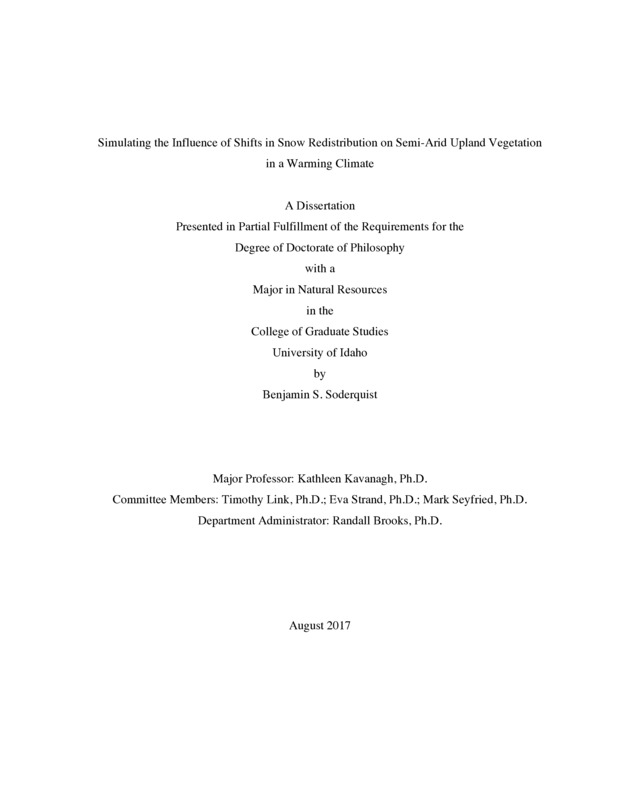Simulating the Influence of Shifts in Snow Redistribution on Semi-Arid Upland Vegetation in a Warming Climate
Soderquist, Benjamin Scott. (2017). Simulating the Influence of Shifts in Snow Redistribution on Semi-Arid Upland Vegetation in a Warming Climate. Theses and Dissertations Collection, University of Idaho Library Digital Collections. https://www.lib.uidaho.edu/digital/etd/items/soderquist_idaho_0089e_11165.html
- Title:
- Simulating the Influence of Shifts in Snow Redistribution on Semi-Arid Upland Vegetation in a Warming Climate
- Author:
- Soderquist, Benjamin Scott
- Date:
- 2017
- Keywords:
- climate change drought stress net primary productivity rangelands snow
- Program:
- Natural Resources
- Subject Category:
- Ecology; Climate change; Natural resource management
- Abstract:
-
In mountainous regions of the western United States, snow is a primary control on ecohydrological processes. In these environments, complex terrain results in steep temperature and precipitation gradients, leading to the heterogeneous distribution of snow water resources across the landscape. At local scales, the spatial distribution of water resources can be further shaped through the wind driven transport and deposition of snow. In snow dominated, semi-arid environments, melt water generated from snowdrifts may provide critical soil moisture subsidies to upland plant communities. Under warming temperatures, snow dominated precipitation regimes will become increasing rain dominated. In plant communities that are closely coupled with drifting snow, decreases in redistributed precipitation along with longer and drier growing seasons could reduce soil moisture availability and increase drought stress. A process model coupled with historic and future climate was used to assess the impacts of shifts in climate and precipitation phase on upland vegetation. Specifically, the response of three widespread rangeland species and plant functional types found in drift zones at three sites in a snow-dominated semi-arid watershed were simulated. After accounting for redistributed precipitation, biogeochemical simulations indicate that snowdrifts have historically provided supplemental soil moisture to aspen (Populus tremuloides), growing at dry mid-elevation sites. Under future conditions, warmer temperatures increased the average growing season length of aspen approximately two weeks. However, at mid-elevation sites, increased spring aspen productivity was offset by carbon losses incurred from increasingly severe summer drought. The response of co-located mountain big sage (Artimisia tridentata ssp. vaseyana) and C3 grasses varied under mid-21st century conditions. Across all sites, increased growing season length led to increased productivity for mountain big sage. However, despite longer growing seasons, mid-21st century productivity rates for C3 grasses remained relatively unchanged from historical conditions. These results indicate that shifts in precipitation phase and growing season conditions can differentially impact individual species that currently comprise upland plant communities. Future management of rangelands for vulnerable species, wildlife habitat, and carbon sequestration should consider the implications of temperature induced shifts in winter precipitation phase.
- Description:
- doctoral, Ph.D., Natural Resources -- University of Idaho - College of Graduate Studies, 2017
- Major Professor:
- Kavanagh, Kathleen L
- Committee:
- Link, Timothy E; Strand, Eva K; Seyfried, Mark S
- Defense Date:
- 2017
- Identifier:
- Soderquist_idaho_0089E_11165
- Type:
- Text
- Format Original:
- Format:
- application/pdf
- Rights:
- In Copyright - Educational Use Permitted. For more information, please contact University of Idaho Library Special Collections and Archives Department at libspec@uidaho.edu.
- Standardized Rights:
- http://rightsstatements.org/vocab/InC-EDU/1.0/

